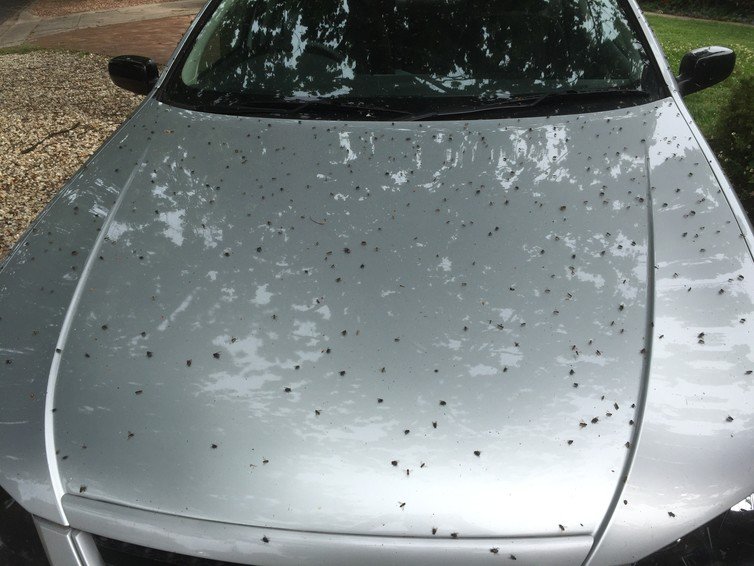From warm to swarm: why insect activity increases in summer

WHILE THE BUREAU of Meteorology is predicting an increase in the average temperature this summer, entomologists are forecasting an increase in insect activity.
It might seem that insects choose to annoy us over the summer, however, the real reason for their population boom is a complex interaction of winter rainfall, availability of food sources and increasing temperatures.
Insects are ectothermic, or “cold-blooded”, meaning their body temperature depends on the external environment. So in summer an increase in temperature typically correlates with an increase in insect activity.
Many insect species emerge from a winter resting phase in spring and summer to begin their winged adult life stages. These highly mobile, hungry, sex-obsessed young adults are the ones that interact with us over summer. Imagine schoolies’ week for insects, lasting an entire three months.
Rain leads to aphids
We all know that a decent rain can be great for our gardens. Last winter was the second wettest on record and rainfall was above average for most of Australia. This means not only did our backyard foliage and flowering plants do well, but so did common varieties of weeds. Common garden weeds around much of eastern and southern Australia include dandelions and sowthistle.
An increase in vegetation over the winter increases the breeding environment for aphids, and the population explodes. Aphids are sap-sucking true bugs (insect order Hemiptera) that can stunt tree growth, destroy flower buds and reduce the quality of fruit.
Most species, including the peach-potato aphid (Myzus persicae), lay eggs on plant stems, leaves and under bark during winter. These eggs hatch in spring or summer as temperatures and day lengths increase. Female aphids can produce 50 to 100 offspring in a very short period.
Natural pest management
Luckily our gardens already have a built-in defence system against aphid attack – flower flies. Flower flies, sometimes called hover flies, are a group of harmless wasp-mimicking flies (order Diptera, family Syrphidae) that you’ve probably noticed in your garden hovering above flowers, giving the flies their common name. They are found all over the world and include more than 6,000 species, 165 of which are unique to Australia.
While some flies, such as mosquitoes, bushflies and blowflies, will try and crash your summer party, most species, such as the flower flies, are busy eating pests in your garden for free. The natural food source of many flower fly larvae (also known as maggots) are nymph and adult aphids. Flower fly larvae eat a staggering number of aphids, potentially clearing a plant of these pests within a matter of hours.
Flower fly larvae eat aphids and are part of your gardens natural pest management.
Aphids spend their days sapping a plant of its fluids, including plant sugars. Consequently their excrement, known as honeydew, is quite sweet. Adult flower flies will seek out aphid honeydew to feed on and lay their eggs close by to ensure that their larvae will have a viable food source.
If you have ever noticed a swarm of adult hover flies resting on your car’s windshield or bonnet, you may have parked under a tree raining aphid honeydew. These flies are feeding on the honeydew stuck to your car.
Flies feeding on honeydew from a car parked under an aphid-infested tree. (Source: CSIRO)
Many other insect predators, such as ladybird larvae and adults, and lacewing larvae (known as aphid lions) are also feasting on the abundance of aphids in our gardens, competing with the flower fly larvae.
So there is quite a lot going on in your garden at this time of year. All of these predators are quite susceptible to insecticides and will be knocked out if you resort to spraying your aphids.
Insects gardening Australia
There are many benefits to having more insects in your garden and community. Many native Australian plants rely on insects for pollination, including a medley of hard working ants, bees, flies, wasps, beetles, butterflies, and moths.
Recent studies have shown that blowflies can carry twice as much pollen and have potential to out-pollinate the European honey bee. Soldier flies also do a fantastic job of turning your organic waste into compost.
So celebrate this summer by firing up the barbecue in the garden and embrace the Aussie salute! Live and let live is a good way to ensure that our natural pest control agents remain intact, although, keep some repellent on hand, just in case.
Bryan Lessard, Postdoctoral Research Fellow, CSIRO and David Yeates, Director of the Australian National Insect Collection, CSIRO
This article was originally published on The Conversation. Read the original article.





